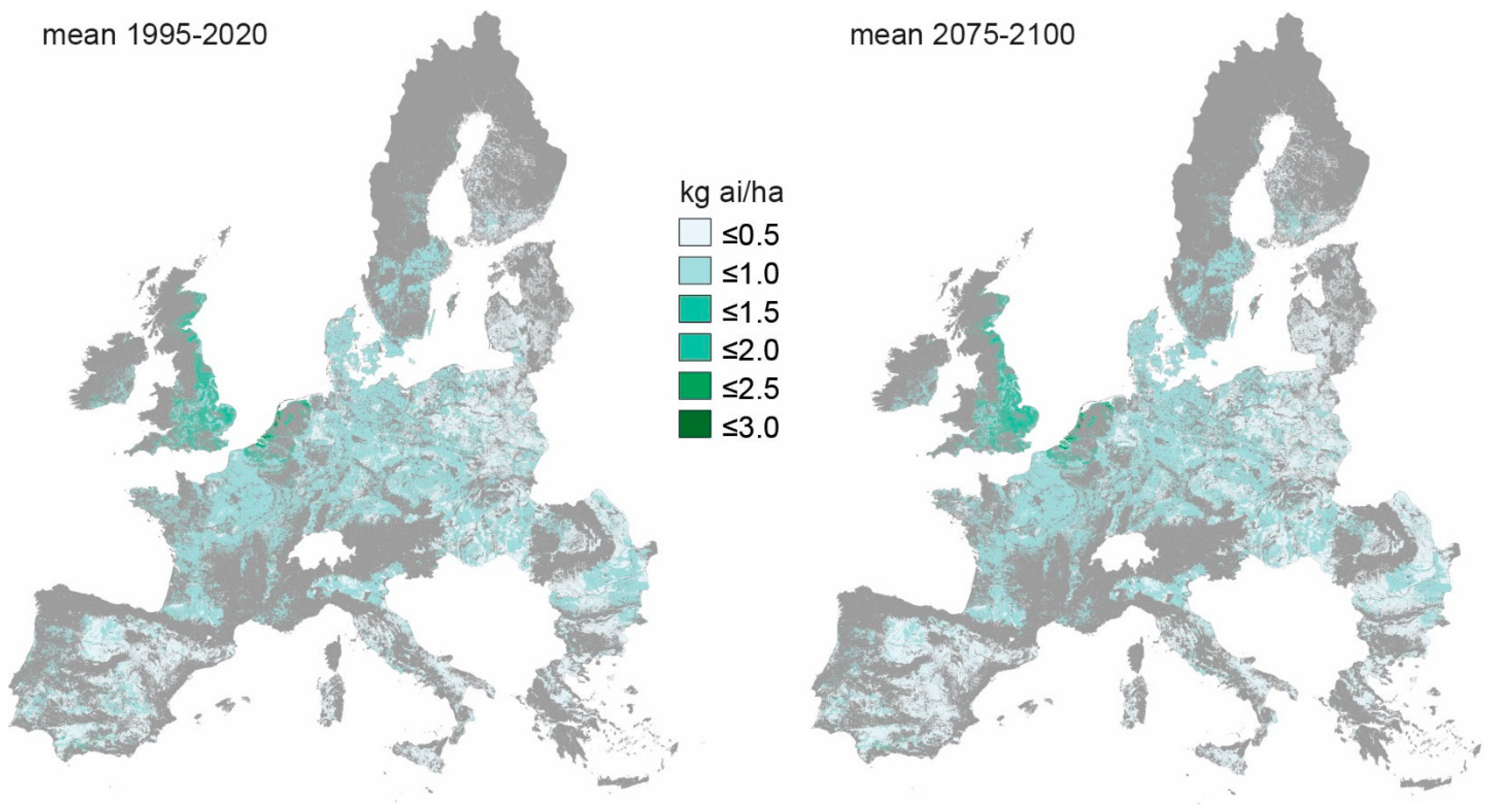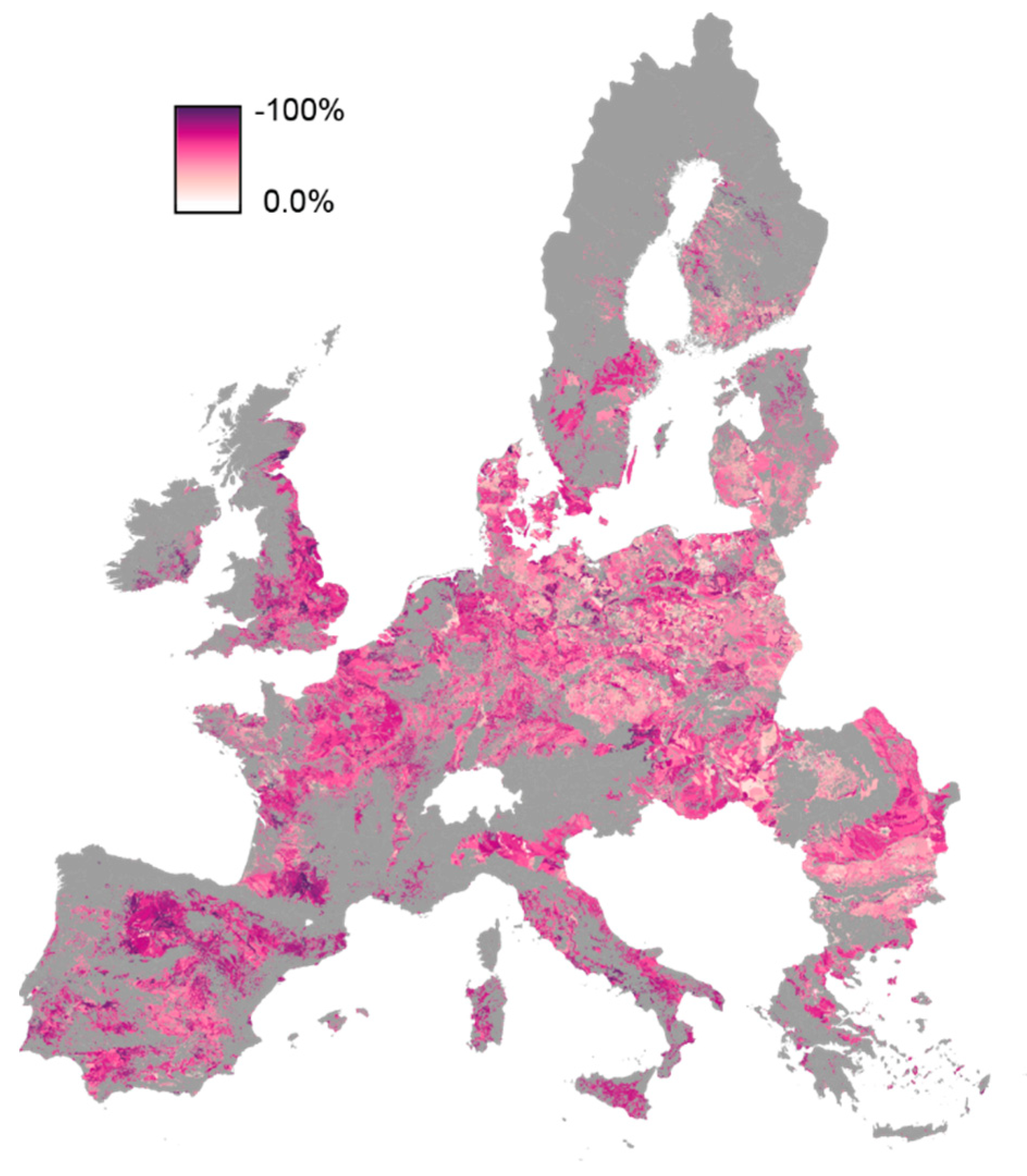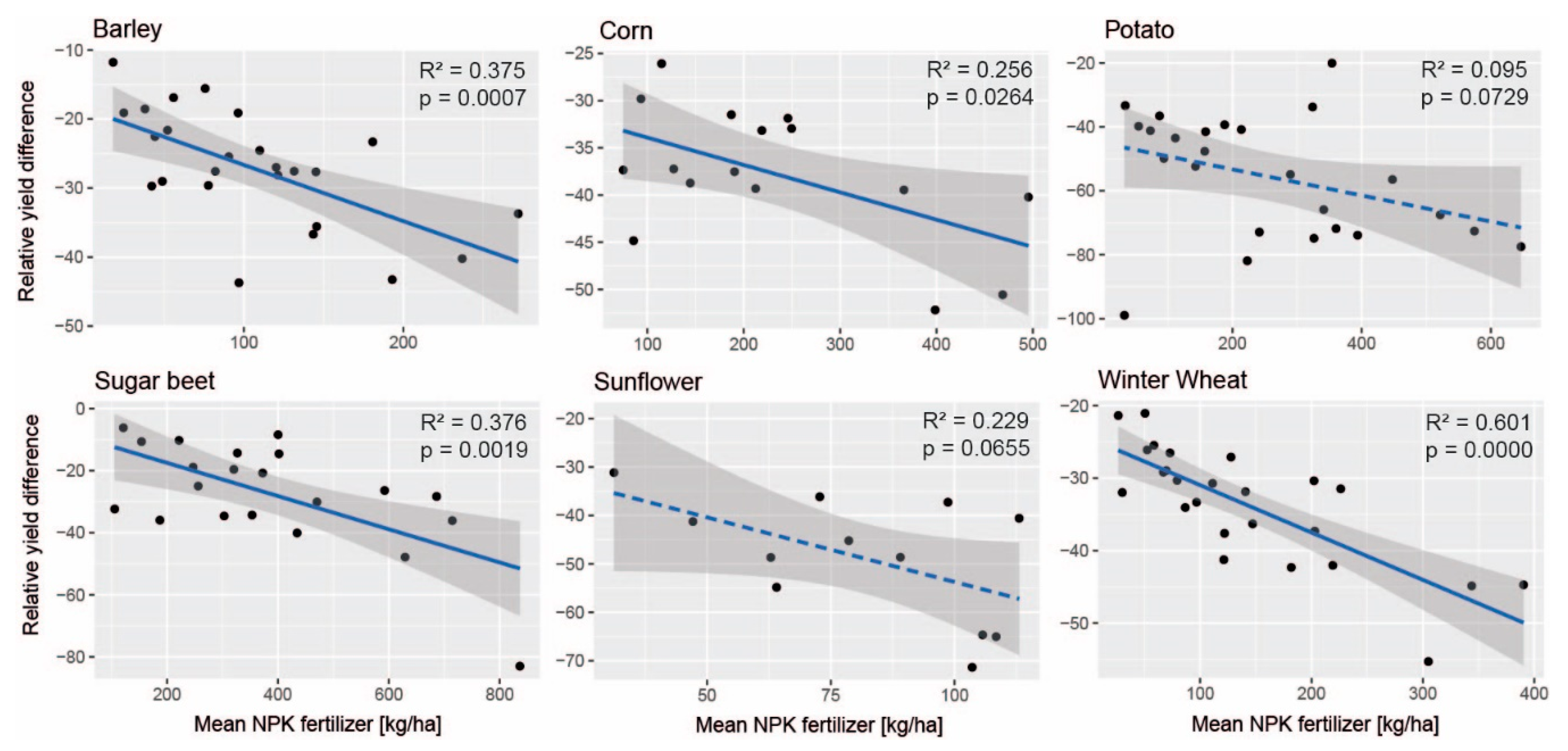Estimating Pesticide Inputs and Yield Outputs of Conventional and Organic Agricultural Systems in Europe under Climate Change
Abstract
:1. Introduction
2. Material and Methods
2.1. Pest-EPIC Model
2.2. Data
2.3. Scenarios and Simulation Settings
2.4. Calibration
3. Results
3.1. Will Pesticide Application Rates Change in the Next Decades Due to Higher Pest Pressure?
3.2. How Large Is the Simulated Yield Gap between Conventional Agriculture and Organic Agriculture in Europe?
3.3. Will the Yield Gap Change under Climate Change?
3.4. How do Soil Nutrient Values Respond to the Different Cultivation Methods?
4. Discussion
5. Conclusions
Supplementary Materials
Funding
Data Availability Statement
Acknowledgments
Conflicts of Interest
References
- Cooper, J.; Dobson, H. The benefits of pesticides to mankind and the environment. Crop. Prot. 2007, 26, 1337–1348. [Google Scholar] [CrossRef]
- Waterfield, G.; Zilberman, D. Pest Management in Food Systems: An Economic Perspective. Annu. Rev. Environ. Resour. 2012, 37, 223–245. [Google Scholar] [CrossRef]
- Von Witzke, H.; Noleppa, S. EU Agricultural Production and Trade: Can More Efficiency Prevent Increasing ‘Land-Grabbing’ outside of Europe? Humboldt Universität zu Berlin: Berlin, Germany, 2010. [Google Scholar]
- Pimentel, D. Environmental and economic costs of the application of pesticides primarily in the United States. Environ. Dev. Sustain. 2005, 7, 229–252. [Google Scholar] [CrossRef]
- van der Werf, H.M.G. Assessing the impact of pesticides on the environment. Agric. Ecosyst. Environ. 1996, 60, 81–96. [Google Scholar] [CrossRef]
- Willer, H.; Schlatter, B.; Trávníček, J.; Kemper, L.; Lernoud, J. (Eds.) The World of Organic Agriculture. Statistics and Emerging Trends 2020; Research Institute of Organic Agriculture (FiBL): Frick, Switzerland; IFOAM—Organics International: Bonn, Germany, 2020; p. 337. [Google Scholar]
- Letourneau, D.; van Bruggen, A. Crop protection in organic agriculture. In Organic Agriculture: A Global Perspective; Kristiansen, P., Taji, A., Reganold, J.P., Eds.; CSIRO Publishing: Collingwood, ON, Canada, 2006; pp. 93–122. [Google Scholar]
- Erhart, E.; Hartl, W. Soil Protection through Organic Farming: A Review. Org. Farming Pest. Control. Remediat. Soil Pollut. 2009, 1, 203–226. [Google Scholar] [CrossRef]
- Seufert, V.; Ramankutty, N.; Foley, J.A. Comparing the yields of organic and conventional agriculture. Nature 2012, 485, 229–232. [Google Scholar] [CrossRef]
- Ponisio, L.C.; M’Gonigle, L.K.; Mace, K.C.; Palomino, J.; de Valpine, P.; Kremen, C. Diversification practices reduce organic to conventional yield gap. Proc. R. Soc. B-Biol. Sci. 2015, 282. [Google Scholar] [CrossRef] [Green Version]
- Halberg, N.; Sulser, T.B.; Høgh-Jensen, H.; Rosegrant, M.W.; Knudsen, M.T. The impact of organic farming on food security in a regional and global perspective. In Global Development of Organic Agriculture: Challenges and Prospects; Halberg, N., Alrøe, H.F., Knudsen, M.T., Kristensen, E.S., Eds.; CABI Publishing: Wallingford, UK, 2006; pp. 277–322. [Google Scholar]
- Aune, J.B. Conventional, Organic and Conservation Agriculture: Production and Environmental Impact. Sustain. Agric. Rev. 2012, 8, 149–165. [Google Scholar] [CrossRef]
- Alexandratos, N.; Bruinsma, J. World Agriculture towards 2030/2050: The 2012 Revision; FAO: Rome, Italy, 2012; p. 157. [Google Scholar]
- Tilman, D.; Clark, M. Global diets link environmental sustainability and human health. Nature 2014, 515, 518. [Google Scholar] [CrossRef]
- van Ittersum, M.K.; Cassman, K.G.; Grassini, P.; Wolf, J.; Tittonell, P.; Hochman, Z. Yield gap analysis with local to global relevance-A review. Field Crop. Res. 2013, 143, 4–17. [Google Scholar] [CrossRef] [Green Version]
- Donatelli, M.; Magarey, R.D.; Bregaglio, S.; Willocquet, L.; Whish, J.P.M.; Savary, S. Modelling the impacts of pests and diseases on agricultural systems. Agric. Syst. 2017, 155, 213–224. [Google Scholar] [CrossRef]
- Savary, S.; Nelson, A.D.; Djurle, A.; Esker, P.D.; Sparks, A.; Amorim, L.; Bergamin Filho, A.; Caffi, T.; Castilla, N.; Garrett, K. Concepts, approaches, and avenues for modelling crop health and crop losses. Eur. J. Agron. 2018, 100, 4–18. [Google Scholar] [CrossRef]
- Tonnang, H.E.Z.; Herve, B.D.B.; Biber-Freudenberger, L.; Salifu, D.; Subramanian, S.; Ngowi, V.B.; Guimapi, R.Y.A.; Anani, B.; Kakmeni, F.M.M.; Affognong, H.; et al. Advances in crop insect modelling methods-Towards a whole system approach. Ecol. Model. 2017, 354, 88–103. [Google Scholar] [CrossRef] [Green Version]
- Bregaglio, S.; Cappelli, G.; Donatelli, M. Evaluating the suitability of a generic fungal infection model for pest risk assessment studies. Ecol. Model. 2012, 247, 58–63. [Google Scholar] [CrossRef]
- Rasche, L.; Taylor, R.A.J. A pest submodel for use in integrated assessment models. Trans. ASABE 2017, 60, 147–158. [Google Scholar]
- Rosenzweig, C.; Iglesias, A.; Yang, X.B.; Epstein, P.R.; Chivian, E. Climate change and extreme weather events. Glob. Chang. Hum. Health 2001, 2, 90–104. [Google Scholar] [CrossRef]
- Luck, J.; Spackman, M.; Freeman, A.; Trebicki, P.; Griffiths, W.; Finlay, K.; Chakraborty, S. Climate change and diseases of food crops. Plant Pathol. 2011, 60, 113–121. [Google Scholar] [CrossRef]
- Gregory, P.J.; Johnson, S.N.; Newton, A.C.; Ingram, J.S. Integrating pests and pathogens into the climate change/food security debate. J. Exp. Bot. 2009, 60, 2827–2838. [Google Scholar] [CrossRef]
- Elias, E.H.; Flynn, R.; Idowu, O.J.; Reyes, J.; Sanogo, S.; Schutte, B.J.; Smith, R.; Steele, C.; Sutherland, C. Crop Vulnerability to Weather and Climate Risk: Analysis of Interacting Systems and Adaptation Efficacy for Sustainable Crop Production. Sustainability 2019, 11, 6619. [Google Scholar] [CrossRef] [Green Version]
- Taylor, R.A.J.; Herms, D.A.; Cardina, J.; Moore, R.H. Climate Change and Pest Management: Unanticipated Consequences of Trophic Dislocation. Agronomy 2018, 8, 7. [Google Scholar] [CrossRef] [Green Version]
- Gomiero, T. Food quality assessment in organic vs. conventional agricultural produce: Findings and issues. Appl. Soil Ecol. 2018, 123, 714–728. [Google Scholar] [CrossRef]
- Meemken, E.M.; Qaim, M. Organic Agriculture, Food Security, and the Environment. Annu. Rev. Resour. Econ. 2018, 10, 39–63. [Google Scholar] [CrossRef] [Green Version]
- Williams, J.R. The EPIC model. In Computer Models of Watershed Hydrology; Singh, V.P., Ed.; Water Resources Publications: Highlands Ranch, CO, USA, 1995; pp. 909–1000. [Google Scholar]
- Izaurralde, R.C.; McGill, W.B.; Williams, J.R.; Jones, C.D.; Link, R.P.; Manowitz, D.H.; Schwab, D.E.; Zhang, X.S.; Robertson, G.P.; Millar, N. Simulating microbial denitrification with EPIC: Model description and evaluation. Ecol. Model. 2017, 359, 349–362. [Google Scholar] [CrossRef]
- Balkovič, J.; van der Velde, M.; Schmid, E.; Skalský, R.; Khabarov, N.; Obersteiner, M.; Sturmer, B.; Xiong, W. Pan-European crop modelling with EPIC: Implementation, up-scaling and regional crop yield validation. Agric. Syst. 2013, 120, 61–75. [Google Scholar] [CrossRef]
- UNIBA. Report on Model Support Services; IIASA: Vienna, Austria, 2010; p. 44. [Google Scholar]
- Eurostat. The Use of Plant Protection Products in the European Union. Data 1992–2003; 9279038907; Office for Official Publications of the European Communities: Luxembourg, 2007; p. 215.
- Schönhart, M.; Schmid, E.; Schneider, U.A. CropRota-a Model to Generate Optimal Crop Rotations from Observed Land Use; DP-45-2009; Institut für nachhaltige Wirtschaftsentwicklung, Department für Wirtschafts- und Sozialwissenschaften, Universität für Bodenkultur: Vienna, Austria, 2009; p. 29. [Google Scholar]
- FERA Science Ltd. Pesticide Usage Tables. Available online: https://secure.fera.defra.gov.uk/pusstats/myindex.cfm (accessed on 13 October 2020).
- Bebber, D.P.; Ramotowski, M.A.T.; Gurr, S.J. Crop pests and pathogens move polewards in a warming world. Nat. Clim. Chang. 2013, 3, 985–988. [Google Scholar] [CrossRef]
- Ghorbani, R.; Wilcockson, S.; Koocheki, A.; Leifert, C. Soil management for sustainable crop disease control: A review. In Organic Farming, Pest Control and Remediation of Soil Pollutants; Lichtfouse, E., Ed.; Springer: Berlin/Heidelberg, Germany, 2010; pp. 177–201. [Google Scholar]
- Wotton, H.R.; Strange, R.N. Increased Susceptibility and Reduced Phytoalexin Accumulation in Drought-Stressed Peanut Kernels Challenged with Aspergillus-Flavus. Appl. Environ. Microb. 1987, 53, 270–273. [Google Scholar] [CrossRef] [PubMed] [Green Version]
- Hoffmann, A.A.; Weeks, A.R.; Nash, M.A.; Mangano, G.P.; Umina, P.A. The changing status of invertebrate pests and the future of pest management in the Australian grains industry. Aust. J. Exp. Agric. 2008, 48, 1481–1493. [Google Scholar] [CrossRef]
- West, J.S.; Townsend, J.A.; Stevens, M.; Fitt, B.D.L. Comparative biology of different plant pathogens to estimate effects of climate change on crop diseases in Europe. Eur. J. Plant Pathol. 2012, 133, 315–331. [Google Scholar] [CrossRef] [Green Version]
- Zvereva, E.L.; Kozlov, M.V. Consequences of simultaneous elevation of carbon dioxide and temperature for plant-herbivore interactions: A metaanalysis. Glob. Chang. Biol. 2006, 12, 27–41. [Google Scholar] [CrossRef]
- Juroszek, P.; von Tiedemann, A. Linking plant disease models to climate change scenarios to project future risks of crop diseases: A review. J. Plant Dis. Protect. 2015, 122, 3–15. [Google Scholar] [CrossRef]
- Oerke, E.C. Crop losses to pests. J. Agric. Sci. 2006, 144, 31–43. [Google Scholar] [CrossRef]
- Popp, J.; Peto, K.; Nagy, J. Pesticide productivity and food security. A review. Agron. Sustain. Dev. 2013, 33, 243–255. [Google Scholar] [CrossRef]
- Smith, E.G.; Knutson, R.D.; Taylor, C.R.; Penson, J.B. Impacts of Chemical Use Reduction on Crop Yields and Costs; AFPC, Department of Agricultural Economics, Texas A&M University, In Cooperation with the National Fertilizer and Environmental Research Center of the Tennessee Valley Authority: Austin, TX, USA, 1990. [Google Scholar]
- Savary, S.; Willocquet, L.; Pethybridge, S.J.; Esker, P.; McRoberts, N.; Nelson, A. The global burden of pathogens and pests on major food crops. Nat. Ecol. Evol. 2019, 3, 430–439. [Google Scholar] [CrossRef] [PubMed]
- van Bruggen, A.H.C. Plant-Disease Severity in High-Input Compared to Reduced-Input and Organic Farming Systems. Plant Dis. 1995, 79, 976–984. [Google Scholar] [CrossRef]
- Börner, H. Pflanzenkrankheiten und Pflanzenschutz; Springer: Berlin/Heidelberg, Germany, 2009. [Google Scholar]
- Colbach, N.; Tschudy, C.; Meunier, D.; Houot, S.; Nicolardot, B. Weed seeds in exogenous organic matter and their contribution to weed dynamics in cropping systems. A simulation approach. Eur. J. Agron. 2013, 45, 7–19. [Google Scholar] [CrossRef]
- Leitch, M.H.; Jenkins, P.D. Influence of Nitrogen on the Development of Septoria Epidemics in Winter. J. Agric. Sci. 1995, 124, 361–368. [Google Scholar] [CrossRef]
- Veresoglou, S.D.; Barto, E.K.; Menexes, G.; Rillig, M.C. Fertilization affects severity of disease caused by fungal plant pathogens. Plant Pathol. 2013, 62, 961–969. [Google Scholar] [CrossRef]
- U.S. Environmental Protection Agency. ECOTOX User Guide: ECOTOXicology Database System. Version 4.0. Available online: http://www.epa.gov/ecotox/ (accessed on 26 September 2015).
- Eurostat. Statistics on Agricultural Use of Pesticides in the European Union; European Comission: Brussels, Belgium, 2019; p. 20.








| Topic | Dataset | Resolution | Description |
|---|---|---|---|
| Agricultural statistics | NEW CRONOS MARS | NUTS2 * 50 km | New Cronos regional statistics (Eurostat) Monitoring of Agriculture with Remote Sensing |
| Climate | IMPACT2C | 0.25° | CSC-REMO2009-MPI-ESM-LR + for RCPs 2.6, 4.5, 8.5 |
| Crop calendars | CGMS MOCA SAGE | 50 km 50 km 5′, 5° | Crop Growth Monitoring System Crop Monographies on Candidate Countries Center for Sustainability and Global Environment |
| Crop rotation | CCTAME | Simulation unit | Optimal rotations calculated with CropRota [33] |
| Crop yields | FAOSTAT | country | Crop yields in 1985–2005 of 23 crops |
| Land cover | CORINE LUCAS | 1 km 2 km | Combined CORINE and PELCOM Land Use/Cover Area Frame Statistical Survey |
| Pesticides | Eurostat | country | The use of plant protection products in the European Union. Data 1992–2003 [32] |
| Soil | ESDB v2 OC TOP v1.2 HYPRES | 10 km 1 km - | The European soil database Map of organic carbon in the topsoils in Europe Database of Hydraulic Properties of European Soils |
| Topography | GTOPO30 | 30″ | Global digital elevation model |
| Pesticide | Source | Cereals | Maize | Oilseeds | Sugar Beet | Potatoes |
|---|---|---|---|---|---|---|
| Fungicides | FERA | 0.11 | 3.60 | 0.19 | 0.35 | 0.59 |
| Eurostat | 0 | 0 | 0.1 | 0 | 13.5 | |
| Herbicides | FERA | 0.46 | 0.81 | 0.48 | 0.31 | 0.55 |
| Eurostat | 2.1 | 0 | 0.9 | 1.9 | 0.7 | |
| Insecticides | FERA | 0.04 | 0.64 | 0.02 | 0.26 | 0.50 |
| Eurostat | 0 | 0 | 0 | 0.4 | 0 |
| Country | Barley | Corn | Peas | Potatoes | Rapeseed | Sugar Beet | W.Rye | W.Wheat |
|---|---|---|---|---|---|---|---|---|
| Austria | −43.71 | −35.9 | −11.23 | −40.83 | −13.73 | −14.29 | −58.92 | −41.25 |
| Belgium | −33.71 | −52.87 | −6.43 | −77.48 | −19.91 | −36.09 | - | −44.86 |
| Bulgaria | −22.54 | −27.86 | - | −36.57 | −27.11 | - | −16.07 | −26.1 |
| Czech Republic | −19.12 | −49.04 | −9.56 | −52.35 | −14.09 | −10.22 | −37.32 | −27.09 |
| Germany | −27.65 | −45.92 | −13.31 | −65.87 | −14.18 | −34.29 | −32.35 | −37.3 |
| Denmark | −27.56 | −30.1 | −19.5 | −73.88 | −2.08 | −40.06 | −20.74 | −30.36 |
| Estonia | −19.1 | - | - | −98.95 | −1.23 | - | −19.62 | −31.98 |
| Spain | −27 | −57.71 | −16.91 | −56.45 | - | −83 | −38.53 | −37.62 |
| Finland | −28.14 | - | −7.97 | −33.76 | −12.62 | −8.39 | −59.24 | −36.3 |
| France | −35.57 | −50.95 | −6.39 | −71.82 | −17.32 | −30.06 | −43.1 | −42.32 |
| Greece | −29.62 | - | −14.17 | −72.91 | - | −47.85 | −32.64 | −34.05 |
| Hungary | −21.62 | −44.66 | −8.06 | −43.49 | −26.02 | −35.94 | −35.31 | −28.95 |
| Ireland | −43.26 | - | - | −20.05 | - | −20.75 | - | −55.3 |
| Italy | −25.45 | −46.03 | −27.23 | −81.88 | −32.89 | −34.6 | −11.19 | −33.32 |
| Lithuania | −18.54 | - | −24.67 | −39.79 | −33.93 | −6.14 | −36.64 | −25.47 |
| Luxemb. | −23.31 | −53.69 | −12.85 | −67.53 | −21.96 | - | - | −31.47 |
| Latvia | −11.78 | - | - | −33.34 | - | - | −27.88 | −21.36 |
| Netherlands | −40.22 | −40.22 | - | −72.58 | −19.75 | −26.36 | −25.81 | −44.72 |
| Poland | −27.57 | −53.09 | −10.93 | −41.49 | −13.32 | −24.95 | −34.16 | −30.72 |
| Portugal | −29.02 | −41.79 | −8.72 | −39.34 | - | −28.3 | −27.5 | −21.05 |
| Romania | −15.58 | −30.41 | −4.14 | −47.63 | −45.94 | −18.84 | −29.23 | −30.31 |
| Sweden | −29.71 | - | −1.89 | −49.86 | −13.74 | −32.33 | −44.37 | −29.18 |
| Slovenia | −24.56 | −26.59 | −2.98 | −54.88 | −13.13 | −14.54 | - | −31.87 |
| Slovakia | −16.9 | −49.48 | −9.26 | −41.17 | −21.72 | −10.61 | −29.29 | −26.52 |
| UK | −36.7 | −41.84 | −2.14 | −74.85 | −18.72 | −19.57 | - | −42.03 |
| Mean | −27.12 | −43.23 | −10.92 | −55.55 | −19.17 | −27.48 | −33.00 | −33.66 |
| Min | −43.71 | −57.71 | −27.23 | −98.95 | −45.94 | −83 | −59.24 | −55.3 |
| Max | −11.78 | −26.59 | −1.89 | −20.05 | −1.23 | −6.14 | −11.19 | −21.05 |
Publisher’s Note: MDPI stays neutral with regard to jurisdictional claims in published maps and institutional affiliations. |
© 2021 by the author. Licensee MDPI, Basel, Switzerland. This article is an open access article distributed under the terms and conditions of the Creative Commons Attribution (CC BY) license (https://creativecommons.org/licenses/by/4.0/).
Share and Cite
Rasche, L. Estimating Pesticide Inputs and Yield Outputs of Conventional and Organic Agricultural Systems in Europe under Climate Change. Agronomy 2021, 11, 1300. https://doi.org/10.3390/agronomy11071300
Rasche L. Estimating Pesticide Inputs and Yield Outputs of Conventional and Organic Agricultural Systems in Europe under Climate Change. Agronomy. 2021; 11(7):1300. https://doi.org/10.3390/agronomy11071300
Chicago/Turabian StyleRasche, Livia. 2021. "Estimating Pesticide Inputs and Yield Outputs of Conventional and Organic Agricultural Systems in Europe under Climate Change" Agronomy 11, no. 7: 1300. https://doi.org/10.3390/agronomy11071300
APA StyleRasche, L. (2021). Estimating Pesticide Inputs and Yield Outputs of Conventional and Organic Agricultural Systems in Europe under Climate Change. Agronomy, 11(7), 1300. https://doi.org/10.3390/agronomy11071300






